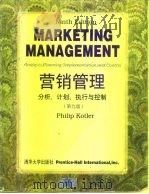《营销管理 分析、计划、执行与控制 第9版英文版》
| 作者 | Philip Kotler著 编者 |
|---|---|
| 出版 | 北京:清华大学出版社 |
| 参考页数 | 789 |
| 出版时间 | 1997(求助前请核对) 目录预览 |
| ISBN号 | 7302024693 — 求助条款 |
| PDF编号 | 87534738(仅供预览,未存储实际文件) |
| 求助格式 | 扫描PDF(若分多册发行,每次仅能受理1册) |

Part I UNDERSTANDING MARKETING MANAGEMENT1
CHAPTER 1 Assessing Marketing's Critical Role in Organizational Performance1
DOING BUSINESS IN THE GLOBAL ECONOMY3
The Global Economy3
The Income Gap4
The Environmental Imperative and Other Business Trends4
Technological Advances5
Focus on the Customer8
Other Issues8
WHAT IS MARKETING? THE CORE CONCEPTS9
Needs, Wants, and Demands9
Products (Goods, Services,and Ideas)9
Value, Cost, and Satisfaction10
Exchange and Transactions11
Relationships and Networks12
Markets13
Marketers and Prospects14
MARKETING MANAGEMENT14
COMMNY ORIENTATIONS TOWARD THE MARKETPLCE17
The Production Concept17
The Product Concept17
The Selling Concept/Sales Concept18
The MarketingConcept19
The Societal Marketing Concept27
THE RAPID ADOPTION OF MARKETING MANAGEMENT29
In the Business Sector29
In the Nonprofit Sector29
In the Global Sector31
SUMMARY31
CONCEPT APPLICATIONS32
NOTES34
CHAPTFR 2 BuildingCustomer Satisfaction Through Quality,Service, and Value36
DEFINING CUSTOMER VALUE AND SATISFACTlON38
Customer Value38
Customer Satisfaction40
DELIVERING CUSTOMER VALUE AND SATISFACTION44
Value Chain44
Value-Delivery Network45
ATTRACTING AND RETAINING CUSTOMERS46
Computing the Cost of Lost Customers46
The Need for customer Retention47
Relatiorship Marketing The Key48
CUSTOMER PROFITABILITY: THE ULTIMATE TEST52
IMPLEMENTING TOTAL QUALITY MARKETING54
SUMMARY58
CONCEPT APPLICATIONS58
NOTES61
CHAPTER 3 Winning Markets Tbrougb Market -Oriented Strategic Planning62
THE NATURE OF HIGH-PERFORMANCE BUSINESSES65
Stakeholders65
Processes66
Resources66
Organization and Organizational Culture67
CORPORATE AND DIVISION STRATEGIC PLANNING68
Defining the Corporate Mission68
Establishing Strategic Business Units70
Assigning Resources to Each SBU71
Planning New Businesses77
Downsizing Older Businesses80
BUSINESS STRATEGIC PLANNING80
Business Mission80
External Environment Analysis (Opportunity and Threat Analysis)81
Internal EnvironmentAnalysis (strengths/Weaknesses Analysis)82
Goal Formulation84
Strategy Formulation84
Program Formulation87
Implementation87
Feedback and Control87
THE MARKETING PROCESS88
Analyzing Marketing Opportunities90
Developing Marketing Strategies91
Planning Marketing Programs92
Managing the Marketing Effort94
PRODUCT PLANNING:THE NATURE AND CONTENTS OF A MARKETING PLAN95
Executive Summary and Table of Contents95
Current Marketing Situation96
Opportunity and Issue Analysis98
Objectives99
Marketing Strategy100
Action Programs100
Projected Profit-and-Loss Statement101
Controls101
THE SHAPE OF MARKETING PLANNING IN THE 1900s101
SUMMARY102
CONCEPT APPLICATIONS103
NOTES106
Part Ⅱ ANALYZING MARKETING OPPORTUNITIES108
CHAPTER 4 Managing Marketing Information and MeasuringMarket Demand108
WHAT IS A MARKETING INFORMATION SYSTEM?110
INTERNAL RECORDS SYSTEM110
The Order-to-Payment Cycle110
Sales Reporting Systems111
MARKETING INTELLIGENCE SYSTEM112
MARKETING RESEARCH SYSTEM113
Suppliers of Marketing Research114
The Marketing Research Process115
The Characteristics of Good Marketing Research124
Overcoming Barriers to the Use of Marketing Research126
MARKETING DECISION SUPPORT SYSTEM127
AN OVERVIEW OF FORECASTING AND DEMAND MEASUREMENT130
Measures of Market Demand131
Which Market to Measure?131
A Vocabulary for Demand Measurement132
Estimating Current Demand135
Estimating Future Demand139
SUmmary141
CONCEPT APPLICATIONS142
NOTES144
CHAPTER 5 Scanning the Marketing Enviroment146
ANALYZING NEEDS AND TRENDS IN THEMACROENVIRONMENT148
IDENTIFYING AND RESPONDING TO THE MAJOR MACROENVIRONMENT FORCES150
Demographic Environment151
Economic Environment156
Natural Environment157
Technological Environment160
Political/Legal Environment160
Social/Cultural Environment164
SUMMARY166
CONCEPT APPLICATIONS167
NOTES169
CHAPTER 6 Analyzing Consumer Markets and Buying Behavior170
A MODEL OF CONSUMER BEHMIOR171
MAJOR FACTORS INFLUENCING BUYINGBEHAVIOR172
Cultural Factors172
Social Factors175
Personal Factors179
Psychological Factors181
THE BUYING PROCESS189
Buying Roles189
Buying Behavior190
The Stages of the Buying Decision Process192
SUMMARY199
CONCEPT APPLICATIONS199
NOTES201
CHAPTER 7 Analyzing Business Markets and Business BuyingBebavior203
WHAT IS ORGANIZATIONAL BUYING?204
The Business Market versus the Consumer Market204
Buying Situations206
Participants in the Business BuyingProcess209
Major Influences on Business Buyers210
The Purchasing/Procurement Process214
INSTITUTIONAL AND GOVERNMENT MANKETS221
SUMMARY222
CONCEPT APPLICATIONS223
NOTES225
CHAPTER 8 Analyzing Industries and Competitors227
IDENTIFYNG COMPETITORS229
Industry Concept of Competition230
Market Concept of Competition233
IDENTIFYING COMPETITORS' STRATEGIES233
DETERMINING COMPETITORS' OBJECTIVES235
ASSESSING COMPETITOR' STRENGTHS AND WEAKNESSES236
ESTIMATING COMPETITORS' REACTION PATTRNS238
DESIGNING THE COMPETITIVE INTELLIGENCESYSTEM240
SELECTING COMPETITORS TO ATTACK AND AVOID241
BALANCING CUSTOMER AND COMPETITOR ORENTATIONS244
SUMMARY245
CONCEPT APPLICATIONS245
NOTES247
CHAPTER 9 Identifying Market Segments and Market Targets248
MARKET SEGMENTATION249
Levels of Market Segmentation250
Patterns of Market Segmentation254
Market-Segmentation Procedure255
Bases for Segmenting Consumer Markets256
Bases for Segmenting Business Markets266
Requirements for Effective Segmentation268
MARKET TARGETING269
Evaluating the Market Segments269
Selecting the Market Segments269
Additional Considerations in Evaluating and Selecting Segments272
SUMMARY275
CONCEPT APPLICATIONS276
NOTES277
CHAPTER 10279
PART Ⅲ DEVELOPING MARKETING STRATEGIES279
Differentiating and Positioning the Market offering~279
TOOLS FOR COMPETITIVE DIFFERFNMATION282
Product Differentiation283
Services Differentiation289
Personnel Differentiation291
Channel Differentiation292
Image Differentiation292
DEVELOPING A POSITIONING STRATEGY294
How Many Differences to Promote?296
Which Differences to Promote?300
COMMUNICATING THE COMPANY'S POSITIONING301
SUMMARY301
CONCEPT APPLICATIONS302
NOTES305
CHAPTER 11 Developing New Products306
CHALLENGES IN NEW-PRODUCT DEVELOPMENT308
EFFECTIVE ORGANIZATIONAL ARRANGEMENTS309
MANAGING THE NEW-PRODUCT DEVELOPMENT PROCESS311
Idea Generation312
Idea Screening315
Concept Development and Testing317
Marketing Strategy Development322
Business Analysis323
Product Development326
Market Testing328
Commercialization332
THE CONUMER-ADOPTION PROCESS335
Stages in the Adoption Process335
Factors Influencing the Adoption Process336
SUMMARY338
CONCEPTAPPLICATIONS338
NOTES341
CHAPTER 12 Managing Life-Cycle Strategies343
THE PRODUCT LIFE CYCLE344
Demand/Technology Life Cycle344
Stages in the ProductLife Cycle345
Product-Category,Product-Form,Product,and Brand Life Cycles346
Other Shapes of the Product Life Cycle347
The International Product Life Cycle350
MARKETING STRATEGIES THROUGHOUT THE PLC350
Introduction Stage350
Growth Stage354
Maturity Stage355
Decline Stage358
Summary and Critique of the Product Life-Cycle Concept362
MARKET EVOLUTION362
Stages in Market Evolution364
Dynamics of Attribute Competition367
SUMMARY368
CONCEPT APPLICATIONS369
NOTES371
CHAPTER 13 Designing Marketing Strategies for Market Leaders, Challengers, Followers, and Nicbers372
MARKet-LEADER STRATGIES373
Expanding the Total374
Defending Market Share376
Expanding Market Share382
Two Case Studies: ProcterGamble and Caterpillar384
MARKET-CHALLENGER STRATEGIES387
Defining the Strategic Objective and Opponent(s)387
Choosing a General Attack Strategy388
Choosing a Specific Attack Strategy391
MARKET-FOLLOWER STRATEGIES393
MARKET-NICHER STRATEGIES395
Niche Specialization396
SUMMARY397
CONCEPT APPLICATIONS399
NOTES400
CHAPTER 14 Designing and Managing Global MarketingStrategies402
DECIDING WHETHER TO GO ABROAD404
DECIDING WHICH MARKETS TO ENTER405
DECIDING HOW TO ENTER THE MARKET409
Indirect Export409
Direct Export410
Licensing410
Joint Ventures412
Direct Investment412
The Internationalization Process413
DECIDING ON THE MARKETING PROGRAM413
Product416
Promotion417
Price419
Place (Distribution Channels)420
DECIDING ON THE MARkETING ORGANIZATION421
Export Department421
International Division421
Global Organization424
SUMMARY425
CONCEPT APPLICATIONS426
NOTES427
Part Ⅳ PLANNING MARKETING PROGRAMS429
CHAPTER 15 Managing Product Lines, Brands, and Packaging429
WHAT IS A PRODUCT?430
Five Levels of a Product431
Product Hierarchy432
Product Classifications433
PRODUCT-MIX DECISIONS435
PRODUCT-LINE DEClSIONS436
Product-Line Analysis437
Product-Line Length438
Line Modernization441
Line Featuring442
Line Pruning442
BRAND DECISIONS442
What Is a Brand?443
The Concept and Measurement of Brand Equity444
Challenges in Branding445
PACKAGING AND LABELING DECISIONS457
Packaging458
Labeling459
SUMMARY460
CONCEPT APPLICATIONS461
NOTES463
CHAPTER 16 Managing Service Businesses and Product Support Services465
THE NATURE AND CLASSIFICATION OF SERVICES467
CHARACTERSTICS OF SERVICES AND THEIR MARKETING IMPLICATIONS468
Intangibility469
Inseparability469
Variability470
Perishability471
MARKETING STKATEGIES FOR SEBVICE FIRMS471
Managing Differentiation474
Managing Service Quality476
Managing Productivity482
MANAGING PRODUCT SUPPORT SERVICES483
Postsale Service Strategy485
SUMMARY488
CONCEPTAPPLICATIONS488
NOTES491
CHAPTER 17 Designing Pricing Strategies and Programs493
SETTING THE PRICE495
Selecting the Pricing Objective496
Determining Demand497
Estimating Costs499
Analyzing Competitors' Costs, Prices, and Offers502
Selecting a Pricing Method502
Selecting the Final Price508
ADAPTING THE PRICE510
Geographical Pricing (Cash, Countertrade, and Barter)510
Price Discounts and Allowances511
Promotional Pricing512
Discriminatory Pricing513
Product-Mix Pricing514
INITIATING AND RESPONDING TO PRICE CHANGES516
Initiating Price Cuts516
Initiating Price Increases517
Reactions to Price Changes520
Responding to Competitors Price Changes521
SUMMARY522
CONCEPT APPLICATIONS523
NOTES527
CHAPTER 18 Selecting andMarketing Channels528
WHAT ARE MARKETINManagingG CHANNELS?530
Why Are Marketing Intermediaries Used?530
Channel Functions and Flows531
Channel Levels533
Channe1s in the Service Sector534
CHANNEL-DESIGN DECISIONS535
Analyzing Customers Desired Service Output Levels537
Establishing the Channel Objectives and Constraints537
Identifying the Major Channel Alternatives538
Evaluating the Major Channel Alternatives541
CHANNEL-MANAGEMENT DECISIONS542
Selecting Channel Members543
Motivating Channel Members544
Evaluating Channel Members545
Modifying Channel Arrangements546
CHANNEL DYNAMICS549
Vertical Marketing Systems549
Horizontal Marketing Systems551
Multichannel Marketing Systems551
Roles of Individual Firms in a Channel552
CHANNEL COOPERATION, CONFLICT AND COMPETITION553
TyPes of ConfLict and Competition553
Causes of Channel Conflict555
Managing Channel Conflict556
Legal and Ethical Issues in Channel Relations557
SUMMARY558
CONCEPT APPLICATIONS559
NOTES560
CHAPTER 19 Managing Retailing,Wholesaling,and Market Logistics562
RETAILILNG563
Types of Retailers563
Retailer Marketing Decisions567
Trends in Retailing579
WHOLESALING583
The Growth and Types of Wholesaling584
Wholesaler Marketing Decisions584
Trends in Wholesaling585
MARKET LOGISTICS589
Market-Logistics Objectives593
Market-Logistics Decisions594
Organizational Lessons About Market Objectives597
SUMMARY598
CONCEPT APPLICATIONS599
NOTES601
CHAPTER 20 Designing and Managing Integrated MarketingCommunications603
A VIEW OF THE COMMUNICATION PROCESS605
DEVELOPING EFFECTIVE COMMUNICATONS607
Identifying the Target Audience607
Determining the Communication Objectives610
Designing the Message611
Selecting the Communication Channels616
Establishing the Total Promotion Budget620
Deciding on the Promotion Mix622
Measuring the Promotion's Results629
Managing and Coordinating Integrated Markering Communications629
SUMMARY632
CONCEPT APPLICATIONS633
NOTES634
CHAPTER 21 Managing Advertising,Sales Promotion,and Public Relations636
DEVELOPING AND MANAGING AN ADVERTISING PROGRAM637
Setting the Advertising Objectives638
Deciding on the Advertising Budget639
Choosing the Advertising Message640
Deciding on the Media648
Evaluating Advertising Effectiveness657
SALES PROMOTION661
The Rapid Growth of Sales Promotion662
PurPose of Sales Promotion662
Major Decisions in Sales Promotion663
PUBLIC RELATIONS671
Major Decisions in Marketing PR673
SUMMARY678
CONCEPT APPLICATIONS679
NOTES681
CHAPTER 22 Managing the Sales Force684
DESIGNING THE SALES FORCE686
Sales Force Objectives686
Sales Force Strategy688
Sales Force Structure689
Sales Force Size692
Sales Force Compensation692
MANAGING THE SALES FORCE694
Recruiting and Selecting Sales Representatives694
Training Sales Representatives695
Supervising Sales Representatives696
Motivating Sales Representatives698
Evaluating Sale Representatives701
PRINCIPLES OF PERSONAL SELLING704
Sales Professionalism704
Negotiation707
Relationship Marketing711
SUMMARY713
CONCEPT APPLICATIONS713
NOTES715
CHAPTER 23 Managing Direct and OnlineMarketing717
THE GROWTH AND BENEFITS OF DIRECT MARKETING718
The Growth of Direct Marketing and Electronic Shopping719
The Benefits of Direct Marketing720
CUSTOMER DATABASES AND DIRECT MARKETING721
MAJOK CHANELS FOR DIRECT MARKETING725
Face-to-Face Selling725
Direct-Mail Marketing725
Catalog Marketing729
Telemarketing729
Television and Other Major Media Direct-Response Marketing730
Kiosk Marketing730
Online Channels730
MARKETING IN THE TWENTYFIRST CENTURY: ONLINE MARKETING731
The Benefits of Online Marketing731
On1ine Marketing Channels732
THE GROWING USE OF INTEGRATED DIRECT MARKETING737
PUBUC AND ETHICAL ISSUES IN THE USE OF DIRECT MARKETING739
SUMMARY740
CONCEPT APPLICATIONS740
NOTES742
Part V MANAGING THE MARKETING EFFORT744
CHAPTER 24 Organizing,Implementing,Evaluating,and Controlling Marketing Activities744
COMMANY ORGANIZATION745
MARKETING ORGANIZATION746
The Evolution of the Marketing Department746
Ways of Organizing the Marketing Department748
Marketing's Relations with Other Departments'757
Strategies for Building a Companywide Marketing Orientation761
MARKETING IMPLEMENTATION763
CONTROLLING MARKETING ACTIVITY765
Annual-Plan Control766
Profitability Control770
Efficiency Control774
Strategic Control776
SUMMARY784
CONCEPT APPLICATIONS785
NOTES788
1997《营销管理 分析、计划、执行与控制 第9版英文版》由于是年代较久的资料都绝版了,几乎不可能购买到实物。如果大家为了学习确实需要,可向博主求助其电子版PDF文件(由Philip Kotler著 1997 北京:清华大学出版社 出版的版本) 。对合法合规的求助,我会当即受理并将下载地址发送给你。
高度相关资料
-

- 生产作业
- 1997 北京:中国国际广播出版社
-

- 市场营销管理 分析、规划、执行和控制 下
- 1991 北京:科学技术文献出版社
-

- 市场营销管理分析、规划、招待和控制 下
- 1991 北京:科学技术文献出版社
-

- 投资分析与管理 英文版·第5版 英文版
- 1998 北京:机械工业出版社
-

- 网络时代的市场营销 英文版 第9版 英文版
- 1999 机械工业出版社
-

- 营销管理分析、计划和控制
- 1996 西蒙与舒斯特国际出版公司;上海:上海人民出版社
-

- 管理控制系统 英文版·第9版
- 1998 北京:机械工业出版社
-

- 财务管理分析 英文版 第5版
- 1998 北京:机械工业出版社
-

- 决策与控制会计 英文版·第2版
- 1998 沈阳:东北财经大学出版社;McGraw-Hill出版公司
-

- 战略管理学 规划、实施与控制 英文版 第6版
- 1998 沈阳:东北财经大学出版社;McGraw-Hill出版公司
-

- 营销管理 分析、计划、执行和控制
- 1999 上海:上海人民出版社;西蒙与舒斯特国际出版公司
-

- 图书馆和情报源利用指南
- 1986 北京:北京大学出版社
-

- 万有文库第一集一千种残废教育
- 1929 商务印书馆
提示:百度云已更名为百度网盘(百度盘),天翼云盘、微盘下载地址……暂未提供。➥ PDF文字可复制化或转WORD

